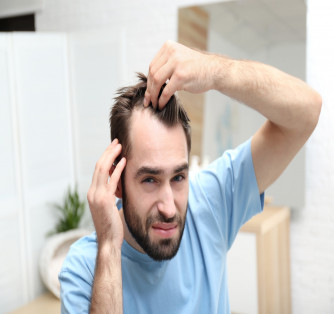Menu
Weight loss
Hormones
Sex
EXPLORE
MEET NU IMAGE MEDICAL
TREATMENTS
MEET NU IMAGE MEDICAL
TREATMENTS
MEET NU IMAGE MEDICAL
What Is Male Pattern Baldness and How Can You Treat It?


Male pattern baldness affects 50 million men in the U.S, and 50% of men by the age of 50.
Facing sudden hair loss can be a traumatic experience for men especially if they’re young. But, luckily, there are viable treatments out there to try.
Still wondering “what is male pattern baldness?”
If so, you’ve come to the right place. Here’s everything you need to know including treatments.
What Is Male Pattern Baldness?
Male pattern baldness, or androgenetic alopecia, follows a pattern of a receding hairline and thinning on the crown.
Every strand of hair sits in a tiny cavity in the skin called a follicle. Male pattern baldness occurs when the hair follicle shrinks, resulting in shorter and finer hair.
Eventually, the follicle doesn’t produce new hair but stays alive so there is still a possibility for hair to grow.
Androgenetic alopecia can affect women too but it’s far less common.
Causes
A major cause is DHT, or dihydrotestosterone, a male sex hormone that attaches to scalp receptors in genetically-susceptible men.
DHT contributes to “male” characteristics like body hair but once high levels of DHT are freely flowing in the bloodstream, DHT shrinks hair follicles so it’s harder to produce a healthy head of hair.
Symptoms of DHT on the scalp include hair thinning, brittleness, and hair loss.
Genetics also affect the chances of male pattern baldness as it shrinks hair follicles so hair grows shorter and finer until no new hair grows. Men with first- and second-degree relatives who lose their hair have a higher chance of losing hair themselves.
Other causes include:
- Iron deficiency
- Excess vitamin A
- Diabetes
- Malnutrition
- Use of anticoagulants (or blood thinners)
Age also plays a large factor especially those over 50.
Treatment
"What's good for hair loss?" You ask. The following treatments can help male pattern baldness, including:
Minoxidil
Minoxidil or Rogaine is an over-the-counter topical treatment that tackles male hair loss.
Apply Minoxidil to your scalp twice a day and let it dry for several hours before touching your hair, showering, or sleeping.
Minoxidil stops hair loss but it’s proven to regrow hair too. You can get 2% or 5% Minoxidil topical solutions and it may take between three to six months to see results.
Finasteride
Otherwise known as Propecia, this is an oral treatment that’s only available by prescription.
Finasteride is a 5-Alpha Reductase Inhibitor which prevents DHT from forming on your scalp, thereby slowing the rate of DHT-related baldness.
You can get Finasteride in 1-milligram tablets which must be taken once a day for three months. The effects can take at least six months to appear and it’s important to note that if you stop taking the pill, the effects will be reversed.
R3 Extra Strength for Hair Growth
This oral supplement should be taken twice per day. It contains important ingredients: biotin to promote hair growth, fish collagen peptides for elasticity, I-cysteine to strengthen hair, and silicon dioxide for shininess.
Shampoo Treatments
There are two types of effective non-prescription shampoo treatments. Nizoral contains 2% ketoconazole, an antifungal medicine that improves hair growth and reduces DHT effects.
You can also try Head and Shoulders shampoo as it contains 1% of pyrithione zinc which de-clogs your follicles from a buildup of dead skin on your scalp.
NuDew
NuDew is one of the most effective ways to solve male pattern baldness as it contains three powerful ingredients: minoxidil, ketoconazole, and finasteride.
As mentioned, these all are essential in improving hair growth so having them work together at once is far more effectual.
NuDew is a prescription drug so discuss this treatment with a physician to return to your hair to its natural glory.
Collagen Powder
Collagen is a protein that strengthens our hair, skin, nails, and bones. If men aren’t getting enough in their diet then they may suffer hair loss.
If this is the case, stir collagen powder into cold water and take eight to 12 milligrams a day.
Low-Level Laser Therapy (LLLT)
Low-level laser therapy is proven to stop hair loss and regrow hair. It’s an easy long-term routine to slip into and you don’t need a prescription.
You can get devices that look like a ballcap, helmet, or a hair decoration that attaches to your head like a wedge. You can also find combs which are useful if you’re often on the move.
LLLT devices glow red as they rely on low-level lasers to target any weak hair follicles and encourage them to grow. LLLT also improves blood flow to the follicles so they can benefit from increased oxygenation and nutrients delivered by the blood.
Follicular Unit Transplantation (FUT)
FUT is a more invasive option where a surgeon removes a section of healthy hair from a less conspicuous part of the head (often the back) and surgically transplants it into the area of hair loss.
Hair transplants aren’t useful if you have short hair as you’ll notice scarring and it’s not practical for large areas of thinning. If you choose FUT, consider the high-cost and recovery time as it’s not suitable for everyone.
The Bottom Line
Now you know the answer to "what is male pattern baldness?"
Luckily, if you experience hair loss, there are many effective treatments to try that don’t have to be invasive. NuDew is one of the most beneficial treatments as it has three powerful components, making it far more effective than other options on this list.
Are you interested in trying NuDew to combat hair loss? If so, contact us here for more details.
This article is for informational purposes only and does not constitute medical advice. The information contained herein is not a substitute for and should never be relied upon for professional medical advice. Always talk to your physician about the risks and benefits of any treatment. Nu Image Medical may not offer the medications or services mentioned in this article.
